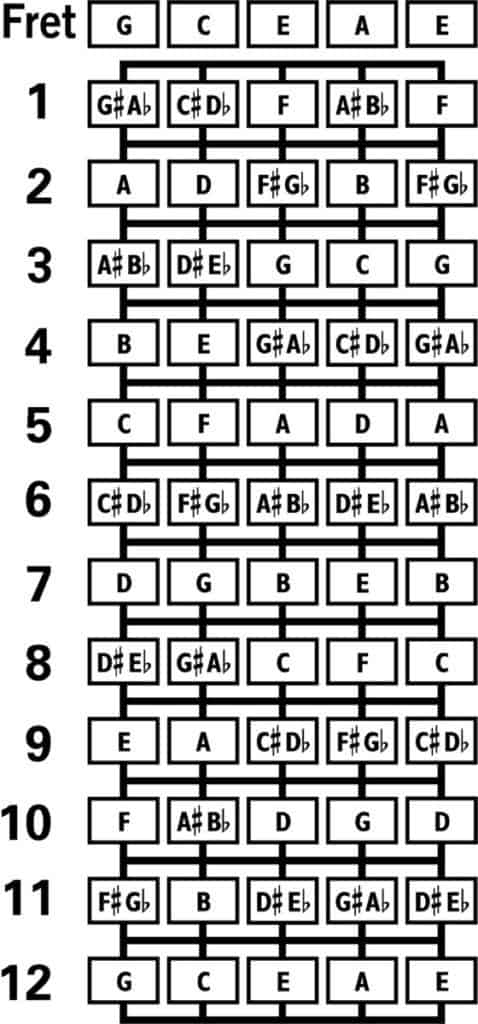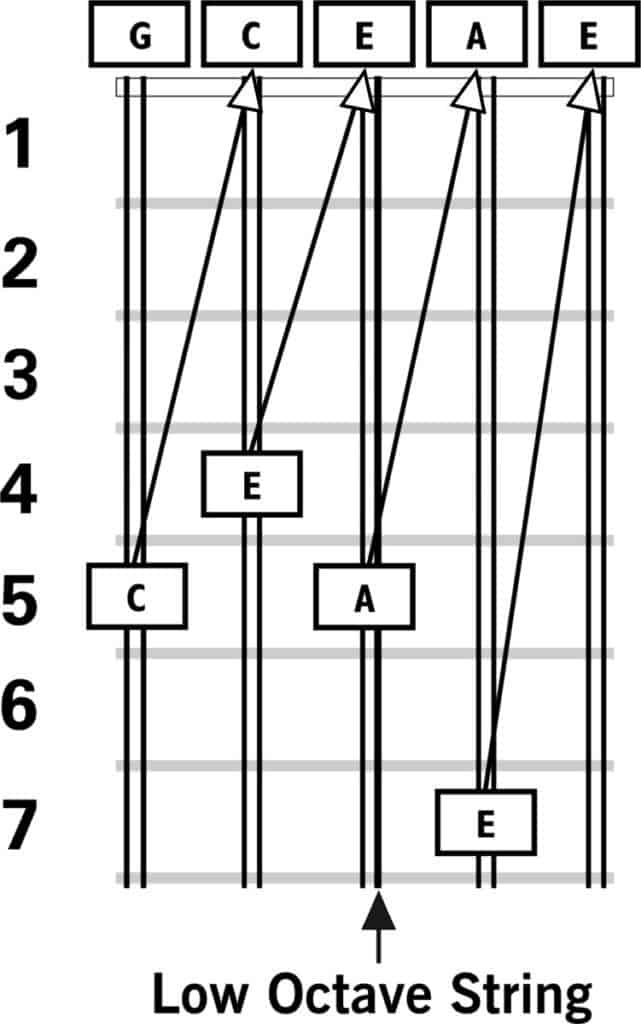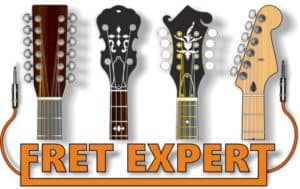It’s a little daunting for a beginner facing the prospect of tuning an instrument with a lot of strings like a charango. In reality, it’s a lot easier than you would imagine.
Although the charango has 10 strings, these are always arranged in matching pairs (or ‘unisons’, using a technical term).
The only exception to this rule is the middle two strings, which are tuned an octave apart (referred to as ‘octaves’).
The charango’s unison stringing arrangement is as follows: strings 1 & 2 (high E), 3 & 4 (A), 7 & 8 (C) and 9 & 10 (G) should all be tuned in pairs to their respective notes.
Only strings 5 & 6 feature the octave stringing configuration, with one ‘E’ tuned to the same note as the high ‘E’ on the 1st and 2nd strings and the other ‘E’, an octave lower.
The charango, like a number of other fretted instruments such as the mandolin, feature double sets of strings. These are referred to as having ‘double courses’ in comparison with single coursed instruments like the guitar or banjo.
Covered in this Article:
What is standard tuning for a charango?
Unlike other members of the charango family, including the ronroco, walaycho and charangon, the charango features a single standard method of tuning.
This removes any confusion which sometimes occurs when discussing the other three instruments in this grouping. Regardless of the country in the Andean region of South America, standard charango tuning is always GCEAE, with the ‘G’ being the string nearest to the player’s chin.
In harmonic terms, the charango is tuned to a C6 chord (C major sixth), just like a ukulele (albeit with an extra course of ‘E’ strings).
This can also be described as an Am7 chord, as the notes are the same as a C6, but in a different order. This gives the chord its own distinctive harmonic ‘feel’. The fingerboard layout is pictured below:

How do I tune my charango?
The first and most accurate method is to use a standard chromatic electronic tuner. You can find my recommended ones here.
Tuning a Charango to a Keyboard or Piano
Another way to tune your charango is to use an electronic keyboard or digital piano. The easiest way to do this is to depress the sustain pedal (if you have one) whilst keying the note you’re tuning to. See the table below.
While the note on the keyboard is sustaining, turn the tuning peg on your instrument until it’s up to the same pitch.
Obviously this method relies to a certain extent on having a good enough ear to hear if a note is sharp or flat, but thankfully most of us can distinguish pitch to a reasonably high degree of accuracy.
Tuning a Charango to a Guitar
Thirdly, you can always tune to a guitar, if it has a built-in electronic tuner, which a lot of electro-acoustic models have today.
To find the correct matching note on the guitar to tune your charango, see below:
| Charango | Guitar | Piano |
|---|---|---|
| 1st & 2nd strings (E) | 1st string (E) fretted at the 12th fret | 2nd E above middle C |
| 3rd & 4th strings (A) | 1st string (E) fretted at the 5th fret | 1st A above middle C |
| 5th Low octave string (E) | 1st open string (E) | 1st E above middle C |
| 6th string (E) | 1st string (E) fretted at the 12th fret | 2nd E above middle C |
| 7th & 8th strings (C) | 1st string (E) fretted at the 8th fret | 1st C above middle C |
| 9th & 10th strings (G) | 1st string (E) fretted at the 3rd fret | 1st G above middle C |
There are also many internet sources with useful audio features that allow you to select and play any note you may wish to use. These are likely to be pretty accurate.
Tuning a Charango To Itself
Lastly, another method is to tune the charango to itself. To do this you need to find the lowest note on your instrument (other than the middle lower octave ‘E’ string) as the starting note.
On the charango, this will be the ‘G’ on the 9th and 10th strings. Then by fretting on specific positions on the fingerboard, you can tune each string until they’re up to pitch. See the illustration below for the correct fretting positions.
With the low octave ‘E’ string, fret this note on the 12th fret and tune it until it matches its high ‘E’ partner. Alternatively, if you have a good ear, tune it until it sounds ‘right’, but an octave lower.

What is the Notation for Tuning a Charango?
The image below illustrates the notation for charango tuning:

Why does my charango keeping going out of tune?
Your instrument going out of tune is a very common problem most charango players have to face when they’ve either replaced an existing string or installed a set of new ones.
The problem also arises if you’ve just bought a new instrument which has, in all likelihood, never been played until you’ve taken it out of the box.
Other factors can also have an effect on pitch stability, including drastic changes in temperature and humidity, as well as transportation and vibration.
If your charango goes out of tune, read my guide to why fretted instruments go out of tune, and how to fix it.
Some strings are also more prone to going out of tune than others, depending on the weight, type, and manufacturer. For more on this, read my charango string guide, including recommendations and ones I use myself.
What are the correct octave designations for charango strings?
Each entry features Scientific Pitch Notation for The Acoustical Society of America (ASA) and Helmholtz.
1st & 2nd string: E5 / E5 or e’’/ e’’
3rd & 4th string: A4 / A4 or a’ / a’
5th & 6th string: E4 / E5 or e’ / e’’
7th & 8th string: C5 / C5 or c’’ / c’’
9th & 10th string: G4 / G4 or g’ / g’
Below, I’ve illustrated the correct octave designations for a charango on a standard 88-note piano keyboard.

What is Scientific Pitch Notation with regard to the Charango?
Every note in the full musical scale has a designated name attached to it. To give you an example, the ‘C’ note in the middle of virtually every piano in existence is described as a ‘C4’. This tells you the note and which octave it should played in. Confusingly, two systems are extensively used, but which you choose doesn’t really matter.
The first was created by The Acoustical Society of America. It uses the numbering system which I’ve briefly described above.
The second is Helmholtz, a labelling system using a combination of upper and lower case note names, combined with apostrophes.
Again, using middle ‘C’ as an example, in Helmholtz it would be written as c’ (lower case c with an apostrophe). Helmhotz is named after German scientist, Hermann von Helmholtz, who originally devised the system.
Another useful piece of information to know about music is that every octave has a specific name. These loosely tie in with the ledger lines on a musical stave or staff. Here’s a list of the octaves from a standard 88-note piano ranging from lowest to highest, using the key of C as an example, along with the corresponding ASA and Helmholtz octave designation abbreviations:
Sub-Contra Octave (C0 or CCC)
Contra Octave (C1 or CC)
Great Octave (C2 or C)
Small Octave (C3 or c)
One-Line Octave (the middle ‘C’ octave) (C4 or c’)
Two-Line Octave (C5 or c’’)
Three-Line Octave (C6 or c’’’)
Four-Line Octave (C7 or c’’’’)
Five-Line Octave (C8 or c’’’’’)
